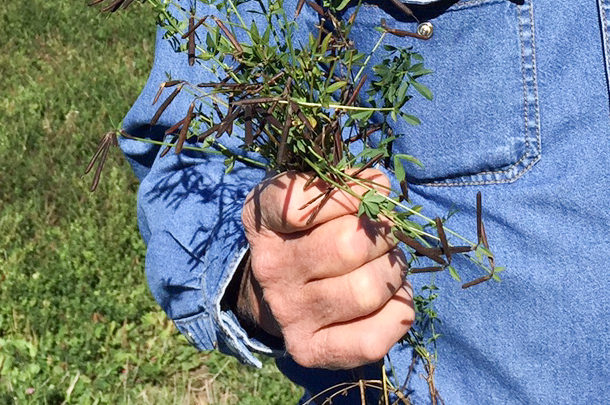About 35 years ago, Jack Hudson of Dafter, Michigan, decided he wanted to farm. He chose to grow birdsfoot trefoil and raised as much as 1,000 acres at one point.
“I didn’t know much about farming, and I thought, ‘Well, here’s a specialty crop that I can learn in the limited amount of time that I have,’” Hudson says.
Birdsfoot trefoil worked well for Hudson. The soils in his area have a pH of 5.8 to 6.0, and trefoil will “tolerate a range of 5.5 to 7.5,” according to the National Resources Conservation Service plant fact sheet. However, trefoil does best within the range of 6.0 to 6.5 pH. This makes it a good alternative legume to alfalfa in acidic soils.
Trefoil also tolerates poorly drained soils. According to Dr. Richard Leep, a retired forage agronomist, trefoil is more resistant to many root rot diseases that affect alfalfa.
While many people find trefoil difficult to establish, Hudson says he finds it an easy crop to establish.
“If you plant it by itself, it’s not difficult to establish,” Hudson says.

It is typically grown with a grass to keep it upright, since it has a thin stem and tends to lie over. Hudson says he doesn’t find this to be a problem. If it’s used for pasture, the cows eat it anyway. When he harvests it for seed, he windrows it, which will pick it up, and then he uses a combine. Leep says that there may be a problem with lodging while making hay.
Hudson says, “A lot of times, people will plant it with red clover and timothy, or orchard grass, or something like that. It’s not as aggressive as some of those other crops. It’s slow to establish if you do that. We always do a clear seeding, 5 pounds to the acre, and we have never had a crop failure in establishment.”
Trefoil is, however, difficult to grow as a seed crop, and Hudson says he has had some crop failures harvesting the seed.
“There’s a good market for the seed. There’s a lot of seed grown in Wisconsin and southern Ontario, and there’s seed also grown in Michigan. That is generally sold to seed brokers, or buyers, and that seed is distributed throughout the U.S. and Canada,” Leep says.
But the right conditions have to be met to get a good seed crop.
“The problems are insect infestations and weather and pollination. This year was very dry, so we had a lot of small pods. Small pods give you small seeds and low germination. It’s one of the risks. If it’s too wet, we don’t get good pollination. If it’s too dry, we don’t get pods filled out. So there are lots of hazards with it,” Hudson says.

In the last five years, Hudson has cut down on seed production and rents his fields out for cattle and bison to graze. He says animals do well grazing trefoil.
Leep helped with a study where they compared the plant production and the gains of dairy heifers on three pastures – orchard grass, orchard grass mixed with trefoil and alfalfa mixed with orchard grass. The study was replicated three times.
“We found that the birdsfoot trefoil-grass yielded a little bit less than alfalfa-grass, but the animal gains were the greatest with birdsfoot trefoil,” Leep says.
Leep also did a study at the University of Michigan with dairy steers on trefoil, ryegrass and alfalfa mixed with ryegrass. Once again, the alfalfa mix produced the most forage, but animal gains were greatest with the trefoil.
Trefoil can’t be grazed as hard as alfalfa. Hudson says that he tries to leave at least 4 inches.
“If you graze it too hard, it will set the stand back. We don’t graze it right down to the ground. We’re particularly careful in the late summer and fall not to graze it back too far,” Hudson says.
If a pasture is grazed too hard, he has to use a no-till grain drill and seed the pasture to give it a boost. Otherwise, trefoil reseeds itself, and Hudson has some stands that are about 40 years old and haven’t ever needed to be replanted.
“Birdsfoot trefoil fills a nice niche. Where alfalfa cannot be grown successfully, birdsfoot trefoil can be grown successfully, and it will produce very good gains,” Leep says. FG
For more information about raising birdsfoot trefoil, check out the following resources:
- The National Resources Conservation Service plant fact sheet for birdsfoot trefoil (PDF, 96KB)
- Pennsylvania State University Extension – birdsfoot trefoil
- Purdue University Agronomy Extension – birdsfoot trefoil production
- The University of Vermont – “Birdsfoot Trefoil as a Grazing or Hay Crop”
PHOTO 1: Jack Hudson holds birdsfoot trefoil pods, which he's found works well for gain in cattle.
PHOTO 2: About 35 years ago, Jack Hudson of Dafter, Michigan, decided he wanted to farm. He chose to grow birdsfoot trefoil and raised as much as 1,000 acres at one point.
PHOTO 3: Jack Hudson and his grandson scout the fields for insects. Photos provided by Jack Hudson.










